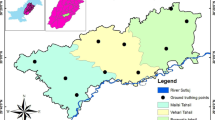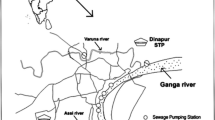Abstract
The present study on accumulation of heavy metals in the vegetables viz. Beta vulgaris, Phaseolus vulgaris, Spinacea oleracea, and Brassica oleracea var. botrytis grown in the wastewater-irrigated soil near the Bindal river, Dehradun, has shown the maximum accumulation of metals for Pb (196.91 ± 8.13 mg/kg), Cu (36.75 ± 6.19 mg/kg), Zn (305.54 ± 14.30 mg/kg), Ni (125.48 ± 5.97 mg/kg), Cd (29.58 ± 4.26 mg/kg), and Cr (93.06 ± 3.25 mg/kg) in agricultural soil irrigated with wastewater. The enrichment factor of soil was maximum for Cr (8.74) and minimum for Cu (0.88). In case of vegetables, the concentrations of heavy metals were maximum for Pb (86.69 ± 6.69) in the flower of B. oleracea var. botrytis, Cu (33.49 ± 2.09) and Zn (161.86 ± 17.79) in the leaves of S. oleracea, Ni (80.72 ± 8.40) and Cd (23.19 ± 2.76), and Cr (57.18 ± 8.16) in the root of B. vulgaris grown in wastewater (WW)-irrigated soil. The bioaccumulation factor (BAF) for Cu (0.911) was maximum in S. oleracea and minimum for Pb (0.440) in B. vulgaris. The maximum daily intake of metals was found for Zn (0.059) in S. oleracea and minimum for Cd (0.008) in B. vulgaris. The human health risk index was found to be more than 1 for Pb and Cd. The long-term wastewater irrigation resulted in accumulation of heavy metals in vegetables which may cause potential health risks to consumers as these vegetables are sold in local markets of Dehradun city.

Similar content being viewed by others
References
Ahmad JU, Goni MA (2010). Heavy metal contamination in water, soil, and vegetables of the industrial areas in Dhaka, Bangladesh. Environmental Monitoring and Assessment., 166:347–357
Antoniadis V, Alloway BJ (2002). The role of dissolved organic carbon in the mobility of Cd, Ni and Zn in sewage sludge-amended soils. Environmental Pollution, 117: 515–521. doi:10.1016/S0269- 7491(01)00172–5.
AOAC (1990). Official methods of analyses. Method no. 975.03 metal in plants, AAS method (15th ed., p. 42). Arlington: Association of Official Analytical Chemists, Inc.
Arora M, Kiran B, Rani S, Rani A, Kaur B, Mittal N (2008). Heavy metal accumulation in vegetables irrigated with water from different sources. Food Chemistry, 111:811–815
Awashthi, S. K. (2000). Prevention of Food Adulteration Act No. 37 of 1954. Central and state rules as amended for 1999 (3rd ed., ). New Delhi: Ashoka Law House.
Chaturvedi RK, Sankar K. (2006). Laboratory manual for the physico-chemical analysis of soil, water and plant. Wildlife Institute of India, Dehradun, pp 97.
Chopra A. K, Pathak C (2012). Bioaccumulation and translocation efficiency of heavy metals in vegetables grown on long-term wastewater irrigated soil near Bindal river, Dehradun. Agricultural Research. DOI 10.1007/s40003-012-0016-8.
Cluis C. (2004). Junk-greedy greens: phytoremediation as a new option for soil decontamination. BioTech Journal, 2, 60–67.
Cui YJ, Zhu YG, Zhai RH, Chen DY, Huang YZ, Qui Y, Liang JZ (2004). Transfer of metals from near a smelter in Nanning, China. Environment International. 30: 785– 791.
EU (2006). Commission regulation (EC) No. 1881/2006 of 19 December 2006 setting maximum levels for certain contaminants in foodstuffs. Official Journal of European UnionL364/5.
Gupta N., Khan D. K., & Santra S. C. (2008). An assessment of heavy metal contamination in vegetables grown in wastewater-irrigated areas of Titagarh, West Bengal, India. Bulletin of Environmental Contamination and Toxicology, 80, 115–118.
Hassan NU, Mahmood Q, Waseem A, Irshad M, Faridullah AP (2013) Assessment of heavy metals in wheat plants irrigated with contaminated wastewater. Polish Journal of Environmental Studies., 22(1):115–123.
Harmanescu M, Maria Alda L, Maria Bordean D, Gogoasa I, Gergen I. (2011). Heavy metals health risk assessment for population via consumption of vegetables grown in old mining area; a case study: Banat County, Romania. Chemistry Central Journal, 5:64
Kabata-Pendias A, Pendias H. (1984). Trace elements in soils and plants. CRC, Press Boca Raton.
Khan S, Farooq R, Shahbaz S, Aziz Khan M, Sadique M (2009). Health risk assessment of heavy metals for population via consumption of vegetables. World Applied Sciences Journal, 6 (12): 1602-1606.
Korboulewsky N, Bonin G, Massiani C. (2002). Biological and ecophysiological reactions of white wall rocket (Diplotaxiserucoides L.) grown on sewage sludge compost. Environmental Pollution, 17: 365–370. doi:10.1016/S0269-7491(01)00165–8.
Korfali S. I., Hawi T., & Mroueh M. (2013). Evaluation of heavy metals content in dietary supplements in Lebanon. Chemistry Central Journal, 7, 10.
Kim KH, Kim, SH (1999). Heavy metal pollution of agricultural soils in central regions of Korea. Water, Air, and Soil Pollution, 111:109–122
Orisakwe O. E., KanayochukwuNduka J., NwadiutoAmadi C., Onyekachi Dike D., & Bede O. (2012). Heavy metals health risk assessment for population via consumption of food crops and fruits in Owerri, South Eastern, Nigeria. Chemistry Central Journal, 6, 77.
Pathak C., Chopra A. K., Kumar V., & Sharma S. (2011). Effect of sewage-water irrigation on physico-chemical parameters with special reference to heavy metals in agricultural soil of Haridwar city. Journal of Applied and Natural Science, 3(1), 108–113.
Pescod MB. (1992). Wastewater treatment and use in agriculture. FAO irrigation and drainage paper 47. Food and Agriculture Organization of the United Nations, Rome
Mishra V. K., Upadhyay A. R., & Tripathi B. D. (2009). Bioaccumulation of heavy metals and tow organochlorine pesticides (DDT and BHC) in crops irrigated with secondary treated wastewater. Environmental Monitoring and Assessment, 156, 99–107.
Mishra A, Tripathi BD (2008). Heavy metal contamination of soil, and bioaccumulation in vegetables irrigated with treated waste water in the tropical city of Varanasi, India. Toxicological and Environmental Chemistry., 90(5):861–871
Sharma RK, Agarwal M, Marshall F (2007). Heavy metals contamination of soil and vegetables in suburban areas of Varanasi, India. Ecotoxicology and Environmental Safety, 66: 258–266
Singh A., Sharma R. K., Agrawal M., & Marshall F. M. (2010). Health risk assessment of heavy metals via dietary intake of foodstuffs from the wastewater irrigated site of a dry tropical area of India. Food and Chemical Toxicology, 48, 611–619.
Sutherland R. A. (2000). Bed sediment-associated trace metals in an urban stream, Oahu, Hawaii. Environmental Geology, 39, 611–627.
USEPA (US Environmental Protection Agency) (2002). Region 9, Preliminary Remediation Goals. http://www.epa.Gov/region09/waste/sfund/prg.
Zhuang P, Zou B, Li NY, Li ZA (2009). Heavy metal contamination in soils and food crops around Dabaoshan mine in Guangdong, China: implication for human health. Environmental Geochemistry and Health. doi:10.1007/s10653-009-9248-3
Acknowledgments
The University Grant Commission, New Delhi, India, is acknowledged for providing the financial support in the form of UGC research fellowship (F.7–70/2007 BSR) to Mr. Chakresh Pathak.
Author information
Authors and Affiliations
Corresponding authors
Rights and permissions
About this article
Cite this article
Chopra, A.K., Pathak, C. Accumulation of heavy metals in the vegetables grown in wastewater irrigated areas of Dehradun, India with reference to human health risk. Environ Monit Assess 187, 445 (2015). https://doi.org/10.1007/s10661-015-4648-6
Received:
Accepted:
Published:
DOI: https://doi.org/10.1007/s10661-015-4648-6




